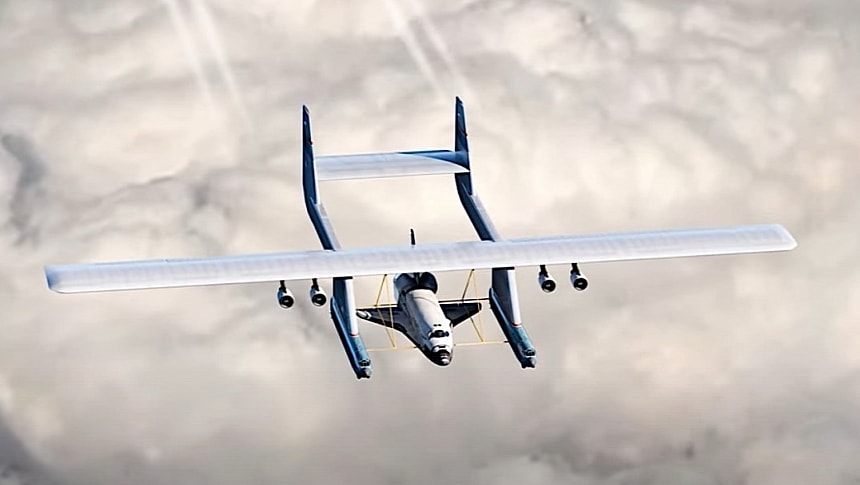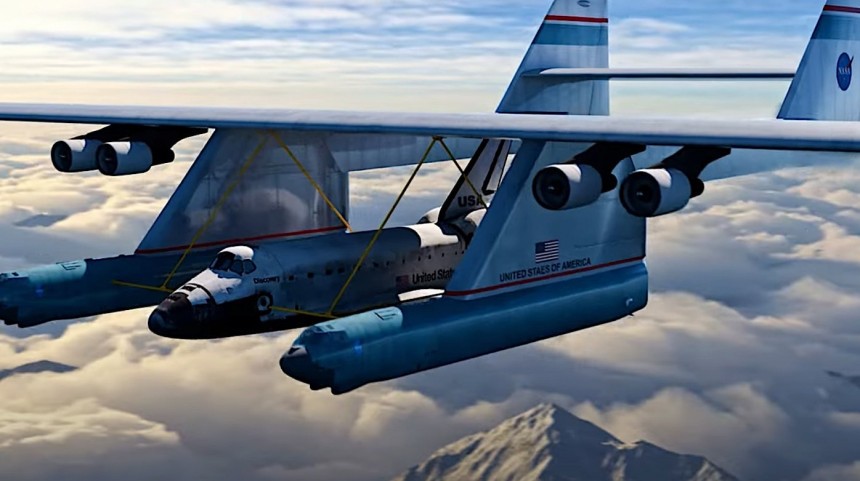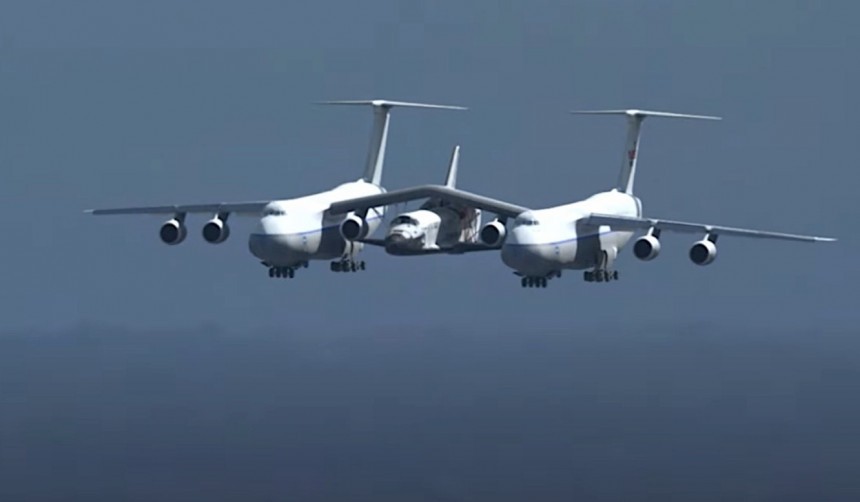There are probably many among you who remember what it was like to see an airplane flying in the sky with a Space Shuttle on its back. It's a sight many Americans got to experience firsthand between 1977 and 2012 as NASA was moving the Shuttle from landing sites back to the Kennedy Space Center. But the reality we got could have been completely different had something called the Conroy Virtus been made.
As you probably know, the Space Shuttles didn't have engines that could have allowed them to maneuver in Earth's atmosphere. The three main ones were used to help push the vehicle up during ascent, and there were orbital maneuvering engines in place, but that was it. When it came down, it more or less glided to the surface.
That meant NASA had no other way of moving the Space Shuttles from wherever they landed than using a means of transport. The list of usual landing locations included the Edwards Air Force Base in California, the White Sands Missile Range in New Mexico, and even Easter Island in the Pacific Ocean as an emergency landing site.
It eventually settled on using two highly modified Boeing 747 airliners that could carry the spaceships on their backs, but wackier designs are known to have been submitted.
One of the was the Conroy Virtus mentioned above. The brainchild of John Conroy, founder of the Turbo-Three Corporation, the aircraft was supposed to be shaped not unlike today's Startolaunch Roc or Virgin Galactic SpaceShipTwo carrier planes: a joining of two airplane fuselages by means of a partially common wing, and with enough space in between them to allow for the Space Shuttle to be attached.
The name Conroy may be familiar. A U.S. Air Force (USAF) pilot by trade, the man is partially responsible for the arrival into this world of the Aero Spacelines Pregnant Guppy and the Super Guppy, two wide-bodied, weirdly shaped cargo aircraft used to carry hardware a lot bigger than what conventional airplanes can carry.
For the task of designing a Space Shuttle transporter, Conroy imagined using the seriously chopped fuselages of two Boeing B-52 Stratofortress nuclear bombers, joined together in such a way as to hold on to the spacecraft together and move it to where it is needed.
A normal Stratofortress is powered by no less than eight engines, but the joining of two into a Shuttle transporter would not have required a total of 16 engines, but only four of them. They would have probably been powerplants of Pratt & Whitney JT9D variaety, the same ones used on the Boeing 747-100.
Technically speaking, the only things the Stratofortress would have contributed to the project were the two aircraft bodies. They would have been fitted with a new tail section and pair of wings, with the payload to be attached in the center section.
Just as it happens these days, the Virtus idea was only one of the proposed solutions for a Space Shuttle transporter, and it competed with designs like the one of the Lockheed Corporation, a twin-fuselage version of the C-5 Galaxy.
The space agency seriously considered the Virtus, and even went as far as to issue a design and development contract for it in 1974. The design made it as far as the wind tunnel testing stage, where it showed a lot of promise.
There was the problem of the aircraft being simply too large to use the existing infrastructure, but the agency seemed willing to give it a go. But then NASA crunched in the numbers and found that the estimated cost of a Virtus would stand at over $80 million in today's money.
That was deemed far too expensive, and despite the fact the aircraft promised to carry not only the Shuttle, but also the external tank or solid rocket boosters if it had to, the project didn't move any further than that. The Galaxy variant too was considered too expensive, and that's how we got the Shuttle carrier we now know.
Neither of the other designs proposed in the 1970s got to fly in the real world, so we don't know how they would have looked soaring to the sky. Luckily, animation specialist Hazegrayart decided to give us a taste, and released this week a six-minute video showing two of the proposals in action.
In the first part of the video we get to see the Lockheed idea, two C-5 Galaxys joined together. Halfway through the video, the Virtus appears, looking positively strange.
The two Stratofortress bodies, stripped of their wings and rear ends, carry pillars on their backs, on top of which a very large, common wing, with a total of four engines, was fitted. The Space Shuttle dangles beneath the same wing, and between the two bomber bodies.
You can enjoy both designs below, and decide which of them you like best.
That meant NASA had no other way of moving the Space Shuttles from wherever they landed than using a means of transport. The list of usual landing locations included the Edwards Air Force Base in California, the White Sands Missile Range in New Mexico, and even Easter Island in the Pacific Ocean as an emergency landing site.
It eventually settled on using two highly modified Boeing 747 airliners that could carry the spaceships on their backs, but wackier designs are known to have been submitted.
One of the was the Conroy Virtus mentioned above. The brainchild of John Conroy, founder of the Turbo-Three Corporation, the aircraft was supposed to be shaped not unlike today's Startolaunch Roc or Virgin Galactic SpaceShipTwo carrier planes: a joining of two airplane fuselages by means of a partially common wing, and with enough space in between them to allow for the Space Shuttle to be attached.
The name Conroy may be familiar. A U.S. Air Force (USAF) pilot by trade, the man is partially responsible for the arrival into this world of the Aero Spacelines Pregnant Guppy and the Super Guppy, two wide-bodied, weirdly shaped cargo aircraft used to carry hardware a lot bigger than what conventional airplanes can carry.
A normal Stratofortress is powered by no less than eight engines, but the joining of two into a Shuttle transporter would not have required a total of 16 engines, but only four of them. They would have probably been powerplants of Pratt & Whitney JT9D variaety, the same ones used on the Boeing 747-100.
Technically speaking, the only things the Stratofortress would have contributed to the project were the two aircraft bodies. They would have been fitted with a new tail section and pair of wings, with the payload to be attached in the center section.
Just as it happens these days, the Virtus idea was only one of the proposed solutions for a Space Shuttle transporter, and it competed with designs like the one of the Lockheed Corporation, a twin-fuselage version of the C-5 Galaxy.
The space agency seriously considered the Virtus, and even went as far as to issue a design and development contract for it in 1974. The design made it as far as the wind tunnel testing stage, where it showed a lot of promise.
There was the problem of the aircraft being simply too large to use the existing infrastructure, but the agency seemed willing to give it a go. But then NASA crunched in the numbers and found that the estimated cost of a Virtus would stand at over $80 million in today's money.
Neither of the other designs proposed in the 1970s got to fly in the real world, so we don't know how they would have looked soaring to the sky. Luckily, animation specialist Hazegrayart decided to give us a taste, and released this week a six-minute video showing two of the proposals in action.
In the first part of the video we get to see the Lockheed idea, two C-5 Galaxys joined together. Halfway through the video, the Virtus appears, looking positively strange.
The two Stratofortress bodies, stripped of their wings and rear ends, carry pillars on their backs, on top of which a very large, common wing, with a total of four engines, was fitted. The Space Shuttle dangles beneath the same wing, and between the two bomber bodies.
You can enjoy both designs below, and decide which of them you like best.













